![]() 1st Battalion 22nd Infantry
1st Battalion 22nd Infantry ![]()
The 22nd Infantry Regiment in Alaska 1908-1910
|
Map of Alaska Marked in red 1 -- Ft. Egbert------------ 2 -- Ft. Wm. H. Seward 3 -- Ft. Gibbon----------- 4 -- Ft. St. Michael------ 5 -- Ft. Davis------------- 6 -- Ft. Liscum----------- |
In the spring of 1908 orders
were issued directing the relief of the 10th Infantry in Alaska
by the Twenty-second Infantry.
This relief was to take place on July 1. Accordingly, on May 3,
Company A of the 22nd proceeded
from Fort McDowell, Cal., to Fort William H. Seward, Alaska, to
make preliminary arrangements for the relief.
Before leaving for its new station the regiment went, on May 7,
to take part in San Francisco
in the parade in honor of the visit of the Atlantic fleet, which
was then on its famous cruise around the world.
Two days later a detachment, consisting of Companies B, I, K and
M, under Major Daniel A. Frederick,
proceeded to Oakland, California, for another parade in honor of
the same event.
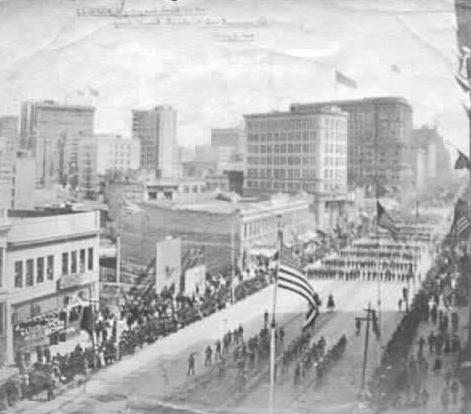
The 22nd Infantry
Regiment marches down the streets of San Francisco
during the parade honoring the Atlantic fleet, May 7, 1908
Early in June, Lieutenants
Ripley, Remington, McCammon, Moore and Adams were sent on to the
stations in Alaska
to complete preparations for the relief of the 10th Infantry and
to take over the property at the various posts.
The sailing date of the regiment was set for June 20, 1908.
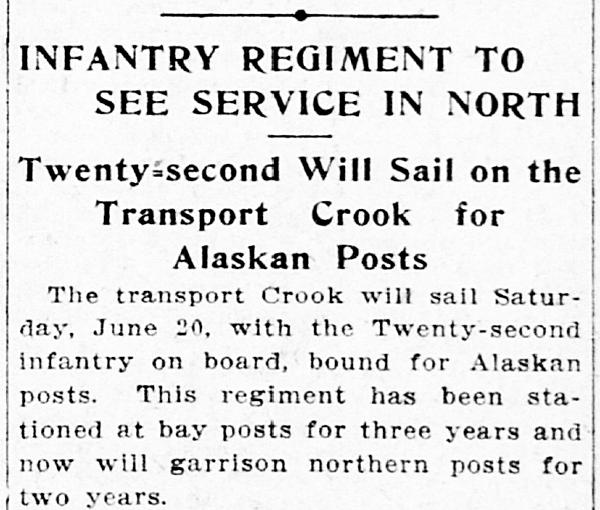
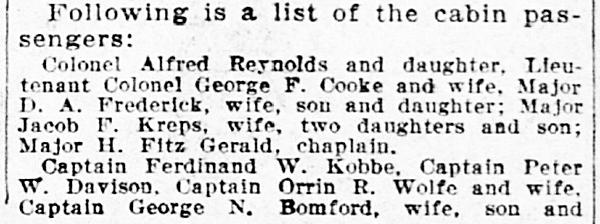
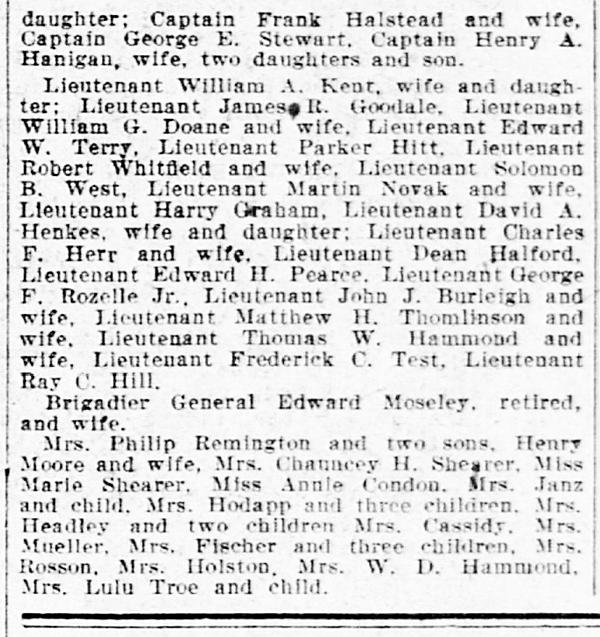
The San Francisco Call Sunday June 14, 1908
CDNC California Digital Newspaper Collection
So on June 20, 1908 the 22nd Infantry left the United States on the army transport Crook, for a tour of service in the north.
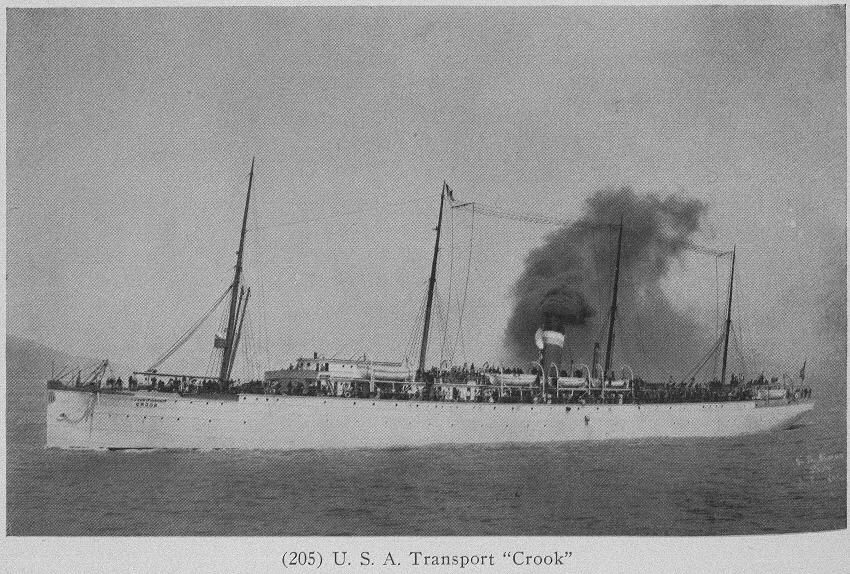
US Army Transport Crook

Postcard of the United States Army
Transport Crook
with the inscription "Sailed from San Francisco Calif June
20 1908 with 22nd Inf Arrived Ft St Michael Alaska"
The Crook reached
Skagway, Alaska, on June 26. Companies G and M immediately
disembarked
and prepared for their move to Fort Egbert, but there being no
adequate transportation available,
they returned to Fort Seward the following day. June 28 and 29,
regimental headquarters, the band,
and Companies F, G and M, took station at Fort William H. Seward.
The remaining units of the regiment proceeded to stations as
follows:
July 2, Companies K and L at Fort Liscum.
July 10, Companies B and E at Fort St. Michael.
July 12, Companies H and I at Fort Davis.
July 20, Companies C and D
proceeded from Fort St. Michael to Fort Gibbon
by traveling up the Yukon on the river boat. Companies G and M,
in the meantime reached Fort Egbert on July 5,
having left Seward four days previously and travelled by railroad
to White Pass, thence by steamer
down the Yukon to their destination. The companies were quickly
settled in their new posts,
and for the remainder of the year engaged in routine garrison
life.
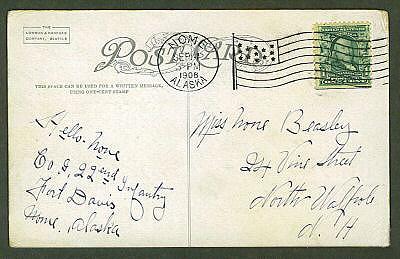
Postcard sent from
Company I, 22nd Infantry at Fort Davis, Alaska,
postmarked September 14, 1908
January 1, 1909, the 22nd Infantry, still under the command of Colonel Alfred Reynolds, was stationed as follows:
Regimental headquarters, band,
machine gun platoon, Companies A and F, Fort Seward,
Colonel Alfred Reynolds, commanding.
Companies G and H, Fort Egbert, Captain Henry A. Harrigan, commanding.
Companies C and D, Fort Gibbon, Lieutenant-Colonel George F. Cooke, commanding.
Headquarters second battalion, Companies B and E, Fort St. Michael, Captain Ferdinand W. Kobbe, commanding.
Headquarters First Battalion, Companies H and I, Fort Davis, Major J. F. Kreps, commanding.
Headquarters Third Battalion, Companies K and L,, Fort Liscum, Captain Frank Halstead, commanding.

Above is a listing of
stations for the 22nd Infantry in Alaska in 1909.
As can been seen, Major Jacob Kreps was the commanding officer at
Fort Davis.
From the Alaska Almanac 1909, Harrison Publishing Company
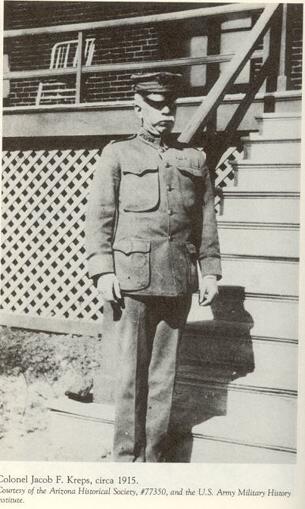
A photo of COL J.F. Kreps of the 22nd
Infantry taken after his retirement.
As a Major, Jacob Kreps was one of the ranking officers of the
22nd during its service in Alaska.
No change of station took place during the year 1909.
January 18, Captain F. G.
Stritzinger, Jr., who had been on duty as an assistant instructor
at the school of musketry,
Presidio of Monterey, was relieved from that assignment and
ordered to Fort Liscum,
where he relieved Captain Halstead in command of the post and of
the Third Battalion, 22nd Infantry.
The year 1909 passed in much the same routine way as had the
previous year,
only one event of interest taking place to break the monotonous
but pleasant service.
A request was made by the United States Marshal at Juneau for a
detachment of troops
to assist him in the apprehension of an Indian accused of murder.
The request having received the approval of the Secretary of War,
a detachment of ten men,
five from each of Companies A and F, under Captain P. W. Davison,
regimental adjutant,
left Fort Seward at 7 A. M., May 31, on the government harbor
boat Peterson.
This detachment joined the marshal at Juneau and accompanied him
to Lake Inlet, Sumdrum,
Windham Bay, Hobart Bay, Cleveland Passage, Port Hough-ton, Kake
Village and back to Juneau.
The suspected murderer was not apprehended and the troops
returned to Fort Seward on June 5.
In the course of this expedition the little detachment traveled
424 miles by water.
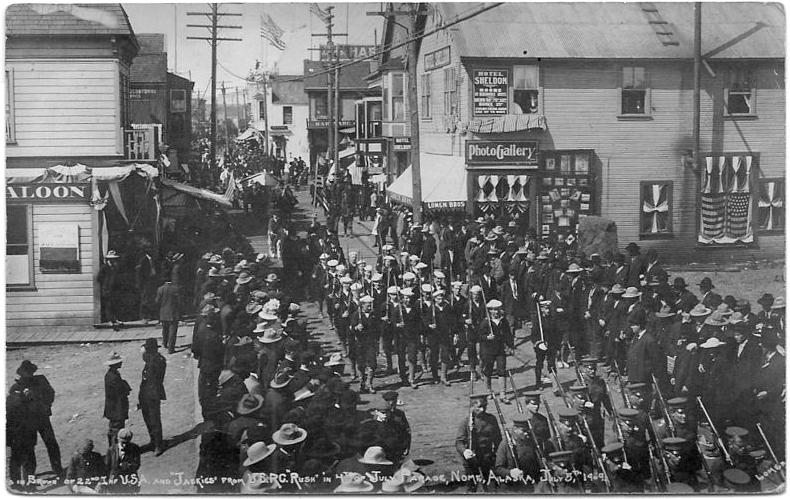
In the bottom right hand
corner of the above photograph, the end of the formation of the
22nd Infantry
can be seen, marching in downtown Nome, Alaska, passing Barracks
Square to the right.
They are captioned on the photo as ' "Boys in Brown" or
22nd Inf U.S.A. '
4th of July parade held on July 5, 1909
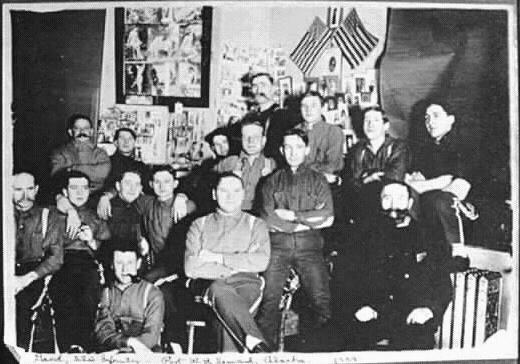
Members of the 22nd Infantry Band, Fort Seward, 1909
|
Menu for Thanksgiving Dinner for Company F and the Machine Gun Platoon Twenty Second Infantry Fort William H. Seward, Alaska November 23, 1909 |
During the year many men from
the regiment were detailed to work with the Signal Corps
on the maintenance and repair of the Alaskan telegraph lines. In
this connection the following telegram,
commending a soldier of the 22nd Infantry for his services,
speaks for itself:
FAIRBANKS,
ALASKA, December 9th, 1909. Signal, Seattle.
"Civilian Meyers reached Minto seventh frozen condition
critical.
Given emergency treatment station men. Brought by Bert Anderson,
Infantry,
credit due Anderson intelligent compliance emergency treatment
and hard travelling temperature forty five below. LEWIS."
Only very limited training was
possible, and during the open season most of the troops were kept
occupied
bringing up supplies to the Yukon posts and Fort Davis. The
condition of the tundra during this season
added to the difficulty of conducting any extensive military
instruction. In spite of this condition, however,
at the conclusion of the target season, the 22nd Infantry had
attained first place in the department
in individual merit firing, and second place in the general
figure of merit.
On February 26, of this year, Chaplain (Major) Edward H.
Fitzgerald retired from active service
and left the regiment. Chaplain Fitzgerald had served
continuously with the regiment since 1897,
and had accompanied it through the Cuban campaign and all of its
service in the Philippines.
The beginning of the year 1910
found the regiment still under the command of Colonel Reynolds,
and at the same stations as the preceding year. Orders had been
received in November, 1909,
that the regiment would return to the United States in the summer
of 1910.
No date was set at that time. It was further announced that on
being relieved
the regiment would proceed to Fort Sam Houston, Texas, for
station.
The customary routine duties of the Alaskan posts occupied the
troops until July, when the transfer took place.
Owing to inclement weather during much of the summer, the annual
target practice was only partially completed
and was later continued and completed in Texas. Prior to the
departure of the regiment from Alaska,
a comprehensive memorandum was prepared by the outgoing officers
covering in detail
all matters relating to the life of the Alaskan garrison. This
was prepared primarily for the use of the officers
of the incoming regiment and their families, and touched on the
methods of obtaining supplies of food and clothing;
shopping facilities, accommodations, amusements, towns in the
vicinity of the various posts, climate,
sports, servants and transportation facilities.
July 3, 1910, the army transport
Buford arrived at Fort William H.
Seward with the Sixteenth Infantry,
which was the relieving regiment. On the same day regimental
headquarters, the band, machine gun platoon
and Companies F, G, H and K of the 16th disembarked and relieved
regimental headquarters, band,
machine gun platoon and Companies A and F of the 22nd Infantry.
The latter troops embarked immediately on the Buford.
The transport left Fort Seward at 6:30 P. M., July 5
and proceeded to Fort Liscum, where it arrived at 5 p. M., July
7. The following day Companies C and I, 16th Infantry,
disembarked and carried out the relief of Companies K and L, 22nd
Infantry, which embarked the same day.
The Buford left Fort Liscum at 6 p. M.,
July 8, and arrived at Fort Davis, Nome, Alaska, at 9 A. M., July
15.
The following day Companies B and E, 16th Infantry, disembarked
and relieved Companies H and I, 22nd Infantry,
the latter companies embarking on the Buford
the same day.
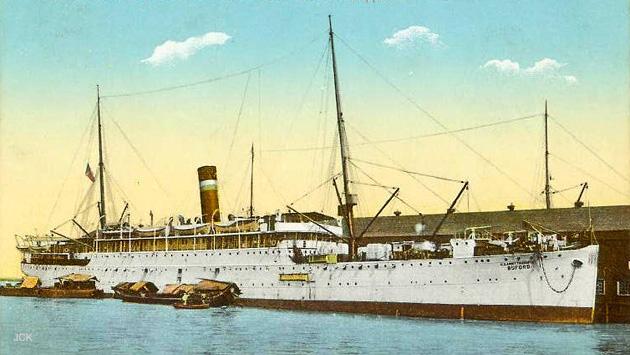
The USAT Buford, here seen in a period
color postcard view,
docked at Manila, The Philippines
While at Nome the 22nd Infantry
band gave two concerts in the town, affording a great deal of
pleasure to the inhabitants.
At 1:30 P. M., July 17, the Buford left Nome for Fort St.
Michael, arriving at that place at 3 A. M., July 18.
Companies D and M, 16th Infantry, disembarked on the 18th,
Companies A and L, on the 19th,
and Companies B, C, D, G, E and M of the 22nd embarked on the
nights of the 18th and 19th.
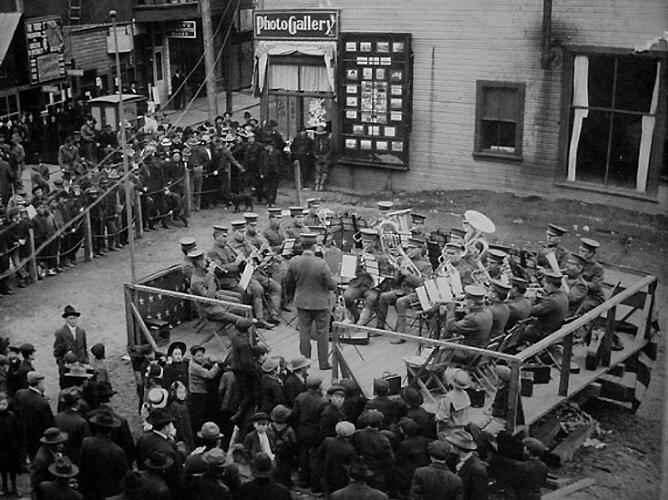
The 22nd Infantry Regimental Band
giving a concert
in Barracks Square, Nome, Alaska July 14, 1910
During the two years the 22nd Infantry was deployed to Alaska five soldiers of the Regiment died.
In December of 1908 three
soldiers died. On December 8, 1908 Corporal William A. Stone of
Company I died of
Pulmonary Turberculosis in the Post Hospital at Fort Davis his
death indicated as having occurred in the line of duty.
On December 14, 1908 Private Thomas J. Fitzpatrick of Company G
died at Fort Egbert. His death was recorded
as a suicide in the Returns of the 22nd Infantry for the month of
December 1908 with the entry " Pistol shot wound -
self inflicted - Not in line of duty."
On December 31, 1908 Private Englebert Stutz of Company E died in
the Post Hospital
at Fort St, Michael. The cause of his death was recorded as an
accident in the Returns of the 22nd Infantry for the month of
December 1908 with the entry "compression of brain, resulting from a fracture
of base of skull with intracranial hemorrhage -
In line of duty." No further details
of the accident were given.
On June 7, 1909 Sergeant Alfred
Jones of Company I drowned at Nome. He had served twelve years in
the 22nd Infantry,
first enlisting in the Regiment on January 28, 1897 at Fort
Crook, Nebraska. In civilian life he had been a railroad
conductor
and listed his home town as Scranton, Pennsylvania. He stood five
feet 4 ¼ inches tall, had light brown hair, brown eyes
and a fair complexion. Jones served with the 22nd Infantry in
Cuba during the War with Spain and accompanied the Regiment
to the Philippines, where at the end of his first enlistment he
had already been promoted to Corporal. By the end of his second
enlistment in 1903 Jones had been promoted to Sergeant. He was
with the Regiment at the Presidio in San Francisco during
the earthquake and was recorded as being a Quartermaster Sergeant
there for a time. Jones was on his fifth three-year enlistment
in the 22nd Infantry when he died in June 1909, having served
over the years in Companies E, G and I. The Returns of the
22nd Infantry for the month of June 1909 gave his entry as "Accidentally drowned in Behring Sea near
Nome, Alaska."
On August 26, 1909 Private Dock
A. Hayes of Company K died while he was a passenger on the
transport S.S. Ohio.
Hayes had enlisted in the Army on February 13, 1909. He was on
his way from Seattle to Nome to join his Regiment
when the ship he was on struck an uncharted underwater reef or
rock in Hiekish Narrows, British Columbia, Canada.
The Captain of the Ohio ordered the ship to steam at full speed
for nearby Carter Bay, Alaska and the ship nearly made it
but flooding sea water caused the ship's boilers to explode and
she quickly sank near the shore in about 90 feet of water.
Only four aboard died. Private Hayes was incapacitated due to
being violently ill from seasickness and three crewman
from the ship attempted to aid him to safety but the ship sank
before they could get him out and all four were lost.
The Returns of the 22nd Infantry for the month of August 1909
recorded that Private Hayes' body was not recovered.
At 5 P. M. July 21, 1910, the Buford,
carrying the entire 22nd Infantry, sailed for San Francisco.
This home port was reached at 2 p. M July 31, after a pleasant
and uneventful voyage.
The regiment disembarked at 1 P. M., August 1, and immediately
entrained at Point Richmond, California,
for the new station at Fort Sam Houston. The journey to San
Antonio, Texas, was made by the Santa Fe route,
and was without event, aside from the natural effect on the
personnel of the sudden change of temperature and climate.
The entire regiment arrived at Fort Sam Houston on August 7, and
was directed to prepare immediately
for the maneuvers to be held at Leon Springs. The regiment
marched to Leon Springs on August 9 and 10.
This, the first long march undertaken by the troops since leaving
Alaska, at a time of the year
when the Texas heat was most intense, caused a considerable
amount of suffering among the men.
The maneuvers at Leon Springs lasted until August 30, and on the
following day camp was broken
and the regiment marched back to Fort Sam Houston, arriving
September 1.
Companies H and I, under command of Lieut-Colonel William C.
Butler, remained at Leon Springs
to complete target practice and returned to the post September
19.
Private James F. Clark Company L
died at the Post Hospital at Fort Sam Houston, Texas on December
3, 1910.
Cause of death was recorded as Bright's Disease.
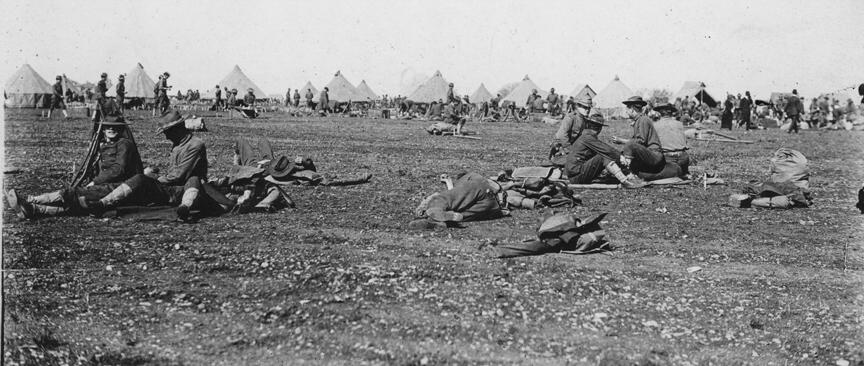
The 22nd Infantry in the
field.
Photo most likely taken at Leon Springs, Texas, 1910
Webmaster's collection
**********************
Home | Photos | Battles & History | Current |
Rosters & Reports | Medal of Honor | Killed
in Action |
Personnel Locator | Commanders | Station
List | Campaigns |
Honors | Insignia & Memorabilia | 4-42
Artillery | Taps |
What's New | Editorial | Links |